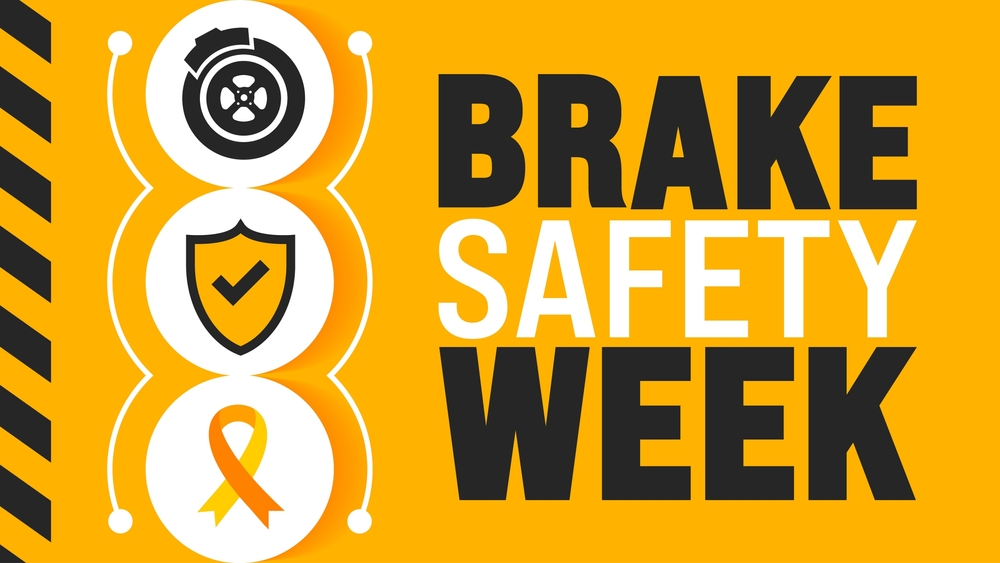Brake Safety Week is an annual safety initiative led by the Commercial Vehicle Safety Alliance (CVSA), designed to promote awareness and enforcement of proper brake system maintenance among commercial motor vehicle operators. It’s part of the broader Operation Airbrake campaign, which aims to reduce the number of crashes caused by faulty braking systems through proactive inspections, education, and outreach.
Brakes are one of the most critical components of any vehicle, and their failure can lead to catastrophic consequences—especially in the commercial trucking and busing industries, where the weight and momentum involved leave little room for error. Each year, inspectors across North America take to the roads during Brake Safety Week to conduct thousands of checks on commercial vehicles, ensuring compliance with brake safety regulations and removing unsafe vehicles from service.
The stakes are high. In past years, brake-related violations have consistently ranked among the top causes of out-of-service orders during roadside inspections. For fleets and drivers, this annual event isn’t just about avoiding fines—it’s about reinforcing a culture of safety and preventing potentially life-threatening accidents.
As Brake Safety Week 2025 approaches, it’s important for fleet managers, drivers, and maintenance teams to understand what to expect, how to prepare, and why this initiative plays such a vital role in roadway safety. This guide will walk you through everything you need to know to stay compliant, confident, and road-ready.
What Is Brake Safety Week?
Brake Safety Week is a targeted inspection and awareness campaign spearheaded by the Commercial Vehicle Safety Alliance (CVSA), in collaboration with law enforcement agencies, transportation safety organizations, and motor carriers across North America. The initiative focuses on identifying and addressing brake system violations in commercial motor vehicles (CMVs), ensuring that trucks and buses on the road are equipped with properly functioning and well-maintained brakes.
Brake Safety Week is part of a larger initiative known as Operation Airbrake, a joint program between the CVSA and the Federal Motor Carrier Safety Administration (FMCSA) in the United States, and the Canadian Council of Motor Transport Administrators (CCMTA) in Canada. This program runs year-round but culminates in a focused enforcement event each year—Brake Safety Week—during which thousands of roadside inspections are conducted across North America.
During this concentrated effort, certified inspectors perform comprehensive checks on commercial vehicles’ brake systems, with an emphasis on specific components that tend to fail or degrade over time. These can include:
- Brake pads and linings
- Air brake hoses and tubing
- Slack adjusters
- Brake chambers
- System pressure levels and air leaks
Vehicles found to have critical brake violations may be placed out of service (OOS) until the issues are resolved, preventing them from operating on public roads and reducing the risk of accidents caused by faulty brakes.
The core goal of Brake Safety Week is to reduce the number of roadway crashes, injuries, and fatalities caused by brake system failures. By promoting proactive maintenance and encouraging accountability within the industry, the initiative helps raise awareness among drivers, maintenance teams, and fleet operators about the importance of brake health and overall vehicle safety.
Beyond enforcement, Brake Safety Week also serves an educational purpose. Many jurisdictions take the opportunity to provide drivers with resources, inspections without penalties, and valuable feedback that can be used to improve ongoing maintenance practices. It’s a time not only for enforcement—but also for learning and improvement.
In short, Brake Safety Week is both a wake-up call and a valuable checkpoint for anyone involved in the commercial transportation sector. It reinforces the message that safe brakes save lives—and that regular maintenance is a responsibility, not a recommendation.
When Is Brake Safety Week 2025?
As of now, the official dates for Brake Safety Week 2025 have not yet been announced by the Commercial Vehicle Safety Alliance. However, based on past years, it’s typically scheduled for a full week in late August, with exact dates released in the months leading up to the event. (We’ll update this section as soon as the CVSA confirms the 2025 dates.)
Brake Safety Week runs for seven consecutive days, during which certified inspectors across the U.S., Canada, and Mexico conduct roadside checks and inspections at weigh stations, rest areas, and other strategic locations. While inspections can happen year-round, this concentrated enforcement period significantly increases the likelihood of vehicles being stopped and reviewed.
Why the Timing Matters
For fleets and drivers, the timing of Brake Safety Week is critical for several reasons:
- Higher Enforcement Activity: Law enforcement agencies ramp up their inspection efforts during this week, meaning the chances of being inspected are much greater than usual.
- Pre-Fall Travel Readiness: The late-summer timing gives fleets the opportunity to address maintenance issues before the heavier travel and shipping periods of fall and early winter. It also helps ensure that braking systems are ready for the change in weather conditions that follow.
- Compliance Preparation: Knowing the timing allows fleet managers to plan inspections, perform brake maintenance, and train drivers in advance—reducing the risk of violations and costly out-of-service orders during the actual event.
- Operational Planning: Fleets may need to adjust dispatch schedules, route planning, or vehicle assignments during this period to accommodate inspections and minimize disruptions.
Even though the official 2025 dates are still pending, it’s wise to begin preparing early. The best strategy? Treat every week like its Brake Safety Week—by maintaining rigorous brake inspection protocols and ensuring your fleet is always road-ready.

What Inspectors Are Looking For
During Brake Safety Week, certified commercial vehicle inspectors conduct detailed inspections with a special focus on the braking systems of trucks, buses, and other commercial motor vehicles. The goal is to identify any brake-related safety violations that could compromise the vehicle’s ability to stop efficiently and safely.
Key Brake-Related Components Inspected
Inspectors follow rigorous procedures based on CVSA’s North American Standard Inspection Program. During Brake Safety Week, extra attention is given to the following components:
- Brake Hoses and Tubing: Inspectors check for chafing, leaks, improper routing, and general wear. Air loss due to damaged hoses is a major violation.
- Air Brake System Components: Includes checking for audible air leaks, condition of air tanks, compressor performance, and system pressure levels.
- Slack Adjusters: These are inspected for proper adjustment and symmetry on each axle. Uneven slack adjusters can lead to braking imbalances.
- Brake Chambers and Pushrods: Checked for damage, alignment, and correct stroke during brake application.
- Rotors, Drums, Pads, and Linings: Worn or contaminated linings, cracked drums, or damaged rotors are common points of failure.
- Automatic Brake Adjusters (ABA): Inspected for proper functioning. If not working as intended, this component can affect brake timing and force.
- Parking Brake System: Verifying full engagement and proper function when applied.
In many cases, inspectors will ask the driver to apply and release the brakes to check for leaks, brake response, and air pressure recovery time.
Inspection Levels Conducted
Most inspections during Brake Safety Week fall under two specific CVSA-defined levels:
- Level I Inspection: This is the most comprehensive type. It includes a 37-step procedure covering both driver and vehicle, including full brake system checks.
- Level V Inspection: Conducted without a driver present, typically at fleet terminals or inspection stations. Focuses solely on the vehicle’s mechanical condition, including the braking system.
In both inspection levels, if brake-related defects are found that pose an immediate risk, the vehicle can be placed out of service until repairs are made.
Most Common Brake Violations from Past Years
Brake-related violations consistently rank among the top reasons commercial vehicles are taken off the road. According to CVSA reports from previous Brake Safety Weeks, the most common issues include:
- Brake hose chafing or kinks
- Excessive brake stroke (out-of-adjustment)
- Air leaks in the brake system
- Missing, cracked, or contaminated brake linings
- Non-functioning ABS warning lamps
In 2023, for example, brake systems accounted for over 25% of all out-of-service violations during inspections. This underscores the ongoing need for thorough maintenance and pre-trip inspections.
Understanding what inspectors are looking for—and preparing accordingly—can help drivers avoid costly penalties and keep vehicles safe on the road. Regular inspections, proactive maintenance, and attention to brake health are essential steps for any fleet hoping to pass Brake Safety Week with flying colors.
How to Prepare for Brake Safety Week
Preparation is key to passing inspections and keeping your fleet on the road during Brake Safety Week. By taking a proactive approach—well before the CVSA begins its focused enforcement campaign—you can significantly reduce the risk of violations, costly downtime, and out-of-service (OOS) orders.
Here’s how to ensure your drivers, vehicles, and maintenance team are ready:
Pre-Trip Inspection Checklists
Drivers are the first line of defense when it comes to spotting brake issues. Daily pre-trip inspections should be thorough and consistent. Include the following brake-related checks:
- Brake Hoses and Tubing: Look for chafing, leaks, or improper connections.
- Air Pressure Levels: Confirm proper pressure buildup (typically 100-125 psi in most systems).
- Slack Adjusters: Ensure even adjustment on both sides; check pushrod travel.
- Brake Linings/Drums: Visually inspect through inspection ports or when safe; look for excessive wear or contamination.
- Low Air Warning System: Confirm the warning activates when pressure drops below the minimum threshold.
- Parking Brake Function: Test full engagement and release.
- ABS Warning Light: Make sure the light comes on at ignition and turns off shortly after.
Tip: Use a brake-specific inspection checklist to help standardize what drivers check each day.
Preventive Maintenance Tips for Brakes
In addition to daily checks, scheduled preventive maintenance (PM) is essential. Here are some best practices for maintenance teams:
- Inspect Slack Adjusters Regularly: Manual slack adjusters require routine adjustment; automatic ones must be verified for proper operation.
- Check Air Dryer System: Especially important in humid or cold climates to prevent moisture from entering the system.
- Lubricate Moving Parts: Ensure components like cams and bushings are well-lubricated to prevent sticking or uneven wear.
- Replace Worn Linings Early: Don’t wait for them to hit the minimum thickness—replace before it becomes an issue.
- Test System for Leaks: Perform periodic leak-down tests to identify pressure loss under full brake application.
Preventive work now can save significant time and money during inspection week.
Driver and Mechanic Training Resources
Education is a powerful tool. Make sure your team is trained and up to date with the latest brake safety standards:
- Driver Training: Conduct refresher courses on how to perform a proper brake inspection, including hands-on demos.
- Mechanic Training: Offer brake system diagnostics and repair courses, especially if new equipment or technology has been introduced.
- Online Resources: Use CVSA and FMCSA guides, videos, and webinars on brake safety.
- Cross-Team Communication: Encourage mechanics and drivers to communicate any concerns early to prevent oversights.
Tip: Create a brake inspection training week leading up to Brake Safety Week to reinforce skills and identify problem areas.
Documentation and Record-Keeping Reminders
Proper documentation shows inspectors that your fleet takes safety seriously. Be sure to:
- Keep Detailed Maintenance Logs: Log all brake inspections, repairs, and component replacements.
- Driver Vehicle Inspection Reports (DVIRs): Ensure drivers are completing and submitting DVIRs daily—and that mechanics are addressing reported defects.
- Store Compliance Records Accessibly: Maintenance files should be easy to retrieve if requested during a terminal or roadside inspection.
- Use Digital Fleet Maintenance Software: If possible, implement a system that alerts you when PM is due or a DVIR reports a brake issue.
Being organized and transparent with your documentation can go a long way during an inspection.
Preparation isn’t just about passing an inspection—it’s about protecting lives. Whether you’re a driver, mechanic, or fleet manager, taking these steps ensures your vehicles are safe, compliant, and reliable—during Brake Safety Week and every day of the year.
Tips for Fleets and Drivers
Proactive coordination and smart planning can make all the difference during Brake Safety Week. It’s not just about mechanics doing their job—it’s a team effort that involves drivers, dispatchers, and fleet managers all working in sync to ensure safety and compliance. Below are practical tips to streamline your approach:
Communication Strategies Between Drivers, Dispatch, and Maintenance Teams
Effective communication is the foundation of a well-prepared fleet. Breakdowns often occur—not just in vehicles, but in the communication chain. Here’s how to tighten it up:
- Create Clear Reporting Channels: Make it easy for drivers to report brake issues in real-time, whether that’s through a mobile app, form, or direct line to dispatch or maintenance.
- Encourage Daily Dialogue: Foster a culture where drivers feel comfortable and encouraged to report even minor brake concerns. A “better safe than sorry” mindset can prevent bigger problems later.
- Conduct Pre-Week Briefings: Hold a short team meeting (in-person or virtual) in the weeks leading up to Brake Safety Week. Set expectations, review common violations, and outline prep steps.
- Assign Point People: Designate a go-to person in each department (dispatch, maintenance, safety) who is responsible for coordinating Brake Safety Week readiness.
Scheduling Inspections Ahead of Time
Avoid the last-minute scramble by creating a plan well in advance. Here’s how to get ahead:
- Perform Internal Brake Inspections Early: Schedule a full brake system review at least 2–4 weeks before Brake Safety Week. This gives you time to fix any issues without pressure.
- Stagger Inspection Appointments: Spread inspections out over several days to avoid bottlenecks in the shop and downtime for drivers.
- Coordinate with Drivers’ Schedules: Align preventive maintenance checks with driver routes and rest days so inspections don’t interfere with delivery timelines.
- Use Mobile Mechanics if Needed: For large fleets or vehicles spread across regions, consider bringing inspections to the vehicle instead of the shop.
By integrating these tips into your Brake Safety Week game plan, you’ll not only boost your chances of passing inspections—you’ll build a safer, more efficient fleet in the process.
Brake Safety Week is about Safeguarding Lives & Protecting your Fleet
Fleetworthy’s tailored vehicle and driver safety compliance solutions give you the digital tools to proactively manage brake maintenance schedules, track inspection data, streamline DVIR processes, and catch potential issues before they become costly violations. With Fleetworthy, you can confidently prepare your drivers and vehicles for Brake Safety Week—and every week—by strengthening your commitment to safety, compliance, and operational excellence.
Schedule your personalized consultation with Fleetworthy today and drive confidently toward lasting compliance and fleet safety.




